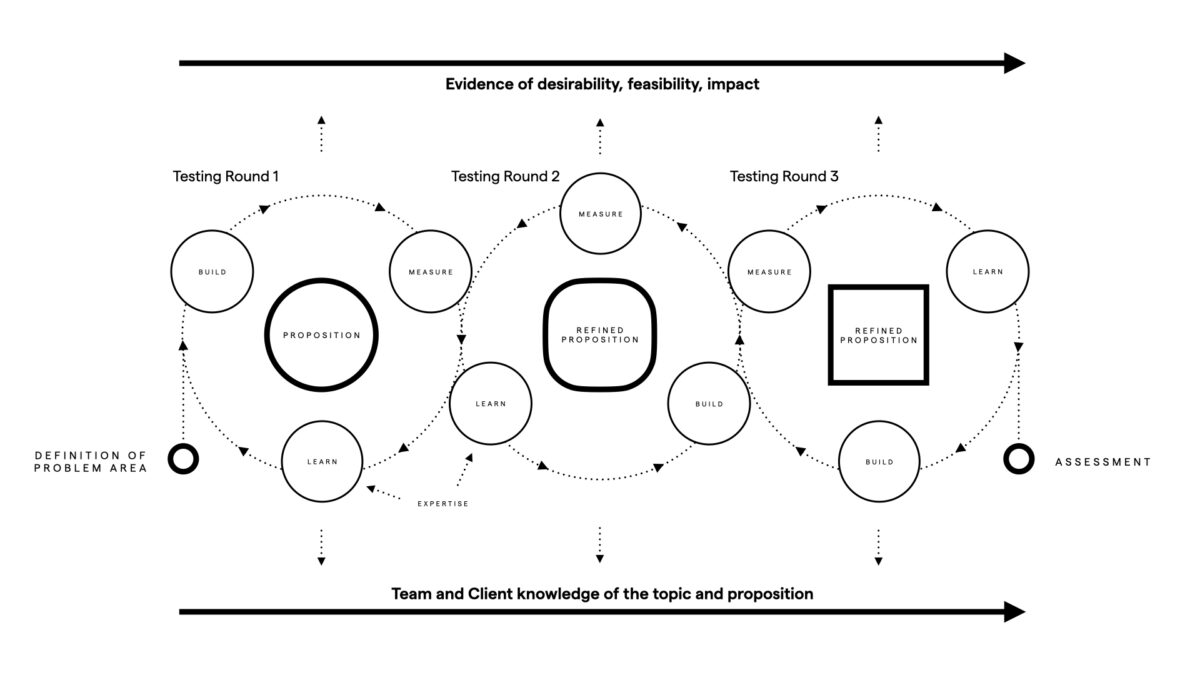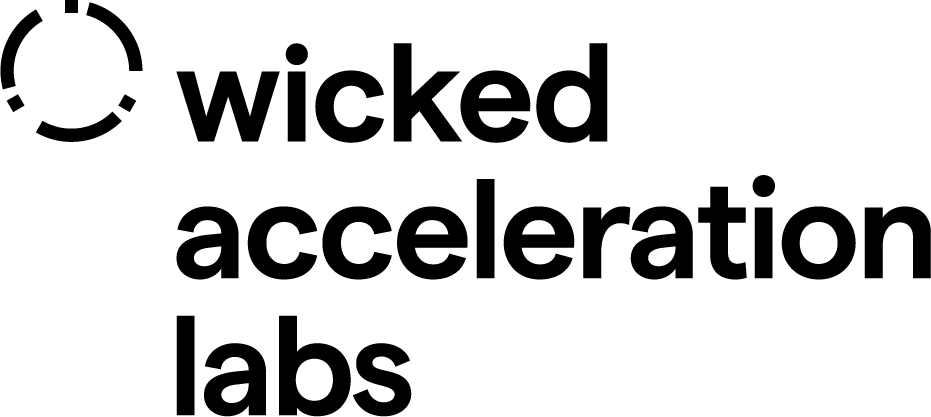Phase 3: Designing Value Propositions
Unit 2: Creating Studio Propositions
Aligning the concepts with the client's strategy
In this unit:
One of the aims was to transform the ‘studio explorations’ (explorations developed by student teams in the previous phase), into more robust, feasible, desirable propositions that were more strategically aligned with the client’s organisational goals.
Another goal was to improve the standard of the proposals and to provide evidence that they were attractive and strategically valuable as propositions, warranting the client’s investment for the next phase.
Overview
Following the selection of the winning studio teams (students) in the previous phase, the methodology shifted.
In this phase, studio teams converged their design efforts into more specific problem areas associated with each of their original concepts and were given support (financial, organisational, advisory) to rapidly test their hypotheses and demonstrate the value of their concepts in order to go forward to the next phase.
To do this, the teams refined their value proposition by conducting further research on the behavioural mechanisms they had integrated into their services, and they delved into the organisational infrastructure and objectives of the client. In doing so, they honed their focus on specific, strategic problems and deepened their expertise.
Subsequently they conducted multiple rounds of experimentation to evaluate different elements, features, attributes or assumptions they had constructed in their propositions. This generated, not only insight, which led to refinement of their concepts, but also data that in many cases acted as evidence of desirability, feasibility, viability or impact.
All this work led to robust, evidence based, (often scientifically founded) proposals of services. The client was then able to use these findings to decide which services to invest in and develop.
Refining the value proposition
During the creation of the studio explorations, the teams were given the freedom to bring their own perspective to the brief and explore the societal dimensions of change without limitations.
After the selection, they were asked to think about how to align their work with the client’s strategy and to select more specific problem areas. The reason for this choice was to make the concepts more focused, making it easier to assess their potential value in terms of impact and from a business point of view.
Another essential part of this stage was to conduct further primary and secondary research on the topic, especially considering the more focused problem area the students were now exploring. They studied in more depth the users’ needs, the opportunities for the technology, the psychological theories, the market and the competitive landscape.
The research helped the students understand what questions were still unanswered and what they should prioritise for testing. Before testing, each team proposed a prototyping plan customised to their research questions, to explore the potential of the mechanisms they had created and the features they designed.

Activities
Activity 01.
Review of the organisation strategy
The first step for the studio teams was to figure out how to align their projects to the client’s strategy. During the work with the lab explorations, the interactions with the client were kept to a minimum to let the students approach the problem freely and avoid getting influenced by the work done already by the lab and the client.
However, for the selected concepts, the intention was to support the students in the validation of their ideas, so that they could collect the evidence needed for a final evaluation, which may lead to a collaboration with the client to launch the services, either through investment or incubation.
Based on their main topic and focus area, the studio teams were given access to some of the existing client research documentation. In some instances, they received support directly from different departments of the company. This helped them better understand the client’s work and strategy and define the next steps to align their projects to the organisation’s way of working.
Activity 02.
Problem area definition
After a deep dive into the client’s work and strategy, each team took some time to decide how to narrow down their problem area. In the previous phase of the project, the students were encouraged to explore and expand the opportunities of their ideas. It was now necessary for them to define a more specific focus area, so that they could test and measure the desirability of their concepts. Each team brainstormed more defined problem areas, looking at sub-themes and topics that might align with the client’s strategy, or they simply turned their focus onto one or two core features from their original concept.
Activity 03.
Primary and secondary research
One of the main activities for the studio was research. The teams returned many times to conduct primary and secondary research to refine their concepts and support them with evidence. Students interviewed users and collected insights about their needs and reached out to researchers, experts and psychologists to validate their assumptions. In parallel, they studied their topics in more depth through desk research, reading articles and finding online resources.
Running experiments
The experimentation methodology for the studio was slightly different from the lab team’s, as they were not comparing multiple concepts, but variations of the same one.
Their method was based on small and frequent iterations, testing single features or elements of the experience, getting feedback on them and refining them again for further prototyping. Each team had multiple rounds of experimentation, collecting qualitative and quantitative data with different modalities, adopting an agile way of working. Each student team received a monthly budget for prototyping and testing, which they managed on their own. Given the different nature of the concepts, each team was free to decide what and how to prototype and received support from the lab team and the client.
The lab team shared their learnings from the testing of the lab propositions and introduced them to some digital methods for prototyping and experimenting, such as creating landing pages and advertising on social media as a way to test desirability. The client’s marketing team also offered support, sharing their experience of testing engagement.
Activities
Activity 1:
Experimentation plan
The activity of planning how to experiment with concepts was not linear. The student teams would frequently redefine their concepts and change strategy based on the results of testing. Generally, the preferred method of prototyping by the students was to test the specific elements of the service individually using quick testing rounds, followed by a refinement of the concept overall. As they drew closer to the assessment, they conducted more extended experiments with recruited users, where they could assess the entire user journey.
Activity 02:
Building of prototypes
The prototypes the studio teams built often focused on getting insights and data on a specific feature or mechanism. Each team creatively came up with different ways to prototype the experience of using the service and test it with users. They experimented with simulated AI bots and web apps, they conducted interviews and surveys, and launched ads campaigns on social media and measured conversions on landing pages. Another important aspect of the prototypes was the branding, each studio team developed branding to represent the concept, and they produced mockups of user
Activity 03.
Experiments in the field
Similarly to the lab team, the studio conducted field research with both recruited users and the general public on social media. However, the teams prioritised testing with these two audiences differently, based on the stage of their projects. One team conducted testing only with recruited users to validate their assumptions on the new problem area, another focused on assessing desirability and building an audience through marketing and advertising, and the third one did some of each strategy.
In general, the first testing rounds were very short and quick, aimed at getting feedback on singular features or elements of the experience. They included presenting the concept to people, having them interact with the prototypes, or collecting sign-ups on the landing pages.
The students experimented with tools they found online to make the experience as close as possible to the actual service they imagined. Some simulated AI chatbots by acting as AI agents on Messenger; in other cases, they used external services to integrate other features into their prototypes.
Active 04.
Synthesis of insights and discussion of learnings
After almost every round of experiment, the students had a check-in session with the client and the lab, to share their insights, learnings and progress and get feedback from a strategic point of view.
These were opportunities for them to synthesise their insights and transform them into actionable plans for the next round of testing.
The reviews with the client also helped them stay aligned with the company’s strategy and identify new potential critical questions to answer with further experimentation. Using those learnings, the studio teams refined the prototypes and conducted new tests.
Activity 05.
Refinement of prototypes
The way the studio experimented was by having multiple loops of refining prototype assets and then showing them to people or testing them with people. However, after each iteration, the focus slightly shifted to different aspects of the service.
In the first rounds of experimentation, they were more interested in validating their value proposition by testing features and mechanisms. For these rounds, they created simple prototypes that could be tested individually, usually for single features or elements of the experience, sometimes as simple as online surveys. In the next rounds, they started creating more complex prototypes that included multiple features of the service mechanisms in order to test the user journey and the engagement with the service. In subsequent rounds, they tested the user experience: how users liked the branding, the interactions and usability.
Each experimentation phase had its own set of prototypes that the studio teams adapted based on the questions they wanted to answer at that specific stage.
Activities
Activity 1:
Experimentation plan
The activity of planning how to experiment with concepts was not linear. The student teams would frequently redefine their concepts and change strategy based on the results of testing. Generally, the preferred method of prototyping by the students was to test the specific elements of the service individually using quick testing rounds, followed by a refinement of the concept overall. As they drew closer to the assessment, they conducted more extended experiments with recruited users, where they could assess the entire user journey.
Activity 02:
Building of prototypes
The prototypes the studio teams built often focused on getting insights and data on a specific feature or mechanism. Each team creatively came up with different ways to prototype the experience of using the service and test it with users. They experimented with simulated AI bots and web apps, they conducted interviews and surveys, and launched ads campaigns on social media and measured conversions on landing pages. Another important aspect of the prototypes was the branding, each studio team developed branding to represent the concept, and they produced mockups of user
Activity 03.
Experiments in the field
Similarly to the lab team, the studio conducted field research with both recruited users and the general public on social media. However, the teams prioritised testing with these two audiences differently, based on the stage of their projects. One team conducted testing only with recruited users to validate their assumptions on the new problem area, another focused on assessing desirability and building an audience through marketing and advertising, and the third one did some of each strategy.
In general, the first testing rounds were very short and quick, aimed at getting feedback on singular features or elements of the experience. They included presenting the concept to people, having them interact with the prototypes, or collecting sign-ups on the landing pages.
The students experimented with tools they found online to make the experience as close as possible to the actual service they imagined. Some simulated AI chatbots by acting as AI agents on Messenger; in other cases, they used external services to integrate other features into their prototypes.
Active 04.
Synthesis of insights and discussion of learnings
After almost every round of experiment, the students had a check-in session with the client and the lab, to share their insights, learnings and progress and get feedback from a strategic point of view.
These were opportunities for them to synthesise their insights and transform them into actionable plans for the next round of testing.
The reviews with the client also helped them stay aligned with the company’s strategy and identify new potential critical questions to answer with further experimentation. Using those learnings, the studio teams refined the prototypes and conducted new tests.
Activity 05.
Refinement of prototypes
The way the studio experimented was by having multiple loops of refining prototype assets and then showing them to people or testing them with people. However, after each iteration, the focus slightly shifted to different aspects of the service.
In the first rounds of experimentation, they were more interested in validating their value proposition by testing features and mechanisms. For these rounds, they created simple prototypes that could be tested individually, usually for single features or elements of the experience, sometimes as simple as online surveys. In the next rounds, they started creating more complex prototypes that included multiple features of the service mechanisms in order to test the user journey and the engagement with the service. In subsequent rounds, they tested the user experience: how users liked the branding, the interactions and usability.
Each experimentation phase had its own set of prototypes that the studio teams adapted based on the questions they wanted to answer at that specific stage.
Assessing and planning
The final assessment was conducted after the end of the students’ final term at the RCA. The studio was invited to present at the client’s headquarters to an extended group of people from the organisation.
The objective was to assess the progress of the projects and how they aligned with the company business strategy in order to make a decision on the next steps.
Activities
Activity 01.
Presentation to the client
The studio teams pitched their projects in front of the client, showcasing the problem and the solution they created and how they had validated it through prototyping and testing. The presentation included a summary of the research and main insights, the introduction to the concept and the main features, the user journey, the prototyping plan and the testing results, as well as an overview of the next steps. The client then assessed the projects based on the alignment with their business strategy and the opportunities they saw for further development.
Activity 02.
Selection and planning of next steps
In the end, the client chose one of the projects to be developed in-house. They saw potential for the project to be integrated with their current strategy and pipeline of products, as it was versatile enough to become part of a broader platform of services.
To this team, the client offered to invest in a MVP, intending to launch it in the market and test impact and engagement.
The other two teams took a different route and were developed as startups. One incubated with InnovationRCA (the startup incubator of the Royal College of Art) with investment from the client. The other chose to start a company autonomously in San Francisco. Both apps have now been launched on the App Store.

Case Studies

Propositions
Edit
Edit is a lifestyle service that helps you edit things in and out of your life through enriched tracking and mini-experiments.




